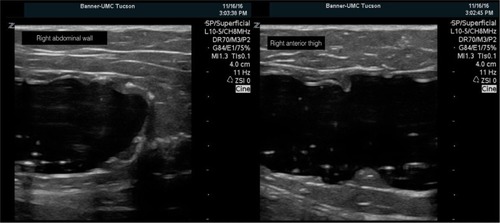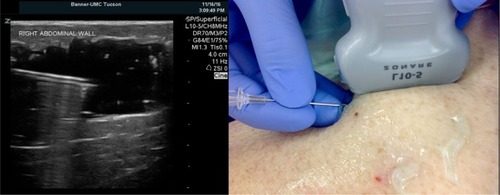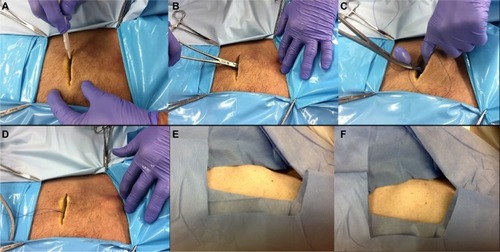Abstract
Ultrasound imaging is a rapid and noninvasive tool ideal for the imaging of soft tissue infections and is associated with a change of clinician management plans in 50% of cases. We developed a realistic skin abscess diagnostic and therapeutic training model using fresh frozen cadavers and common, affordable materials. Details for construction of the model and suggested variations are presented. This cadaver-based abscess model produces high-quality sonographic images with internal echogenicity similar to a true clinical abscess, and is ideal for teaching sonographic diagnostic skills in addition to the technical skills of incision and drainage or needle aspiration.
Introduction
Soft tissue infections are common presenting entities that range from cellulitis to abscess.Citation1,Citation2 Ultrasound is increasingly used to guide the management of soft tissue infections. In fact, when ultrasound is used in patients with cellulitis, clinicians change their management plans 50% of the time.Citation3 Incision and drainage and needle aspiration have been widely accepted as the appropriate treatment of abscesses.Citation4 Criticisms of the synthetic training models are that they have less realistic tactile features and subpar sonographic imaging when compared to cadaver-based models. Although various educational models for training exist in the literature, they have not attempted to simulate the realism of a true abscess under sonographic imaging using a cadaver model.Citation5–Citation7 With the increased utilization of diagnostic ultrasound in medical practice, abscess training models must incorporate the use of ultrasound in these medical training models.Citation8 Furthermore, educational procedural opportunities must be increased to achieve various competencies. The aim of this study is to describe a cadaver-based abscess model designed to aid medical student learning of physical exam and sonographic features associated with soft tissue abscesses, while providing increased exposure to and practice of the incision and drainage or needle aspiration procedures.
Methods
The use of cadavers as a platform for ultrasound training has been shown to increase student confidence in performing future ultrasound-guided skills at our institution.Citation9,Citation10 In addition to a fresh cadaver, the following materials are needed to prepare this training model: a latex balloon, ultrasound gel, normal saline, a number 11 or 15 blade, and an 18-guage needle with 10 cc syringe.
The process begins with the creation of the model abscess. Realistic abscess content texture and echogenicity is simulated using a 1:1 mixture of ultrasound gel:saline. This mixture is inserted via a syringe into a small, round balloon, which is then tied off with suture. (Suture tails may be left to later assist in removal of the balloon from the cadaver following the simulation). The fluid-filled balloon serves numerous functions: it prevents the extravasation of contents; it provides tactile rebound; and provides the sensation of cutting through the wall of an abscess. The balloon method also allows for variation of size and differing degrees of tautness to be simulated depending on the size of the balloon and amount of fluid infused. The overall result is a realistic abscess model with an echogenicity similar to a real abscess cavity and is ideal for ultrasound diagnosis () or needle guidance ().
Figure 1 Ultrasound image showing two simulated subcutaneous abscess cavities (4 cm total depth).

Figure 2 Ultrasound image demonstrating needle drainage technique.

Following fluid-filled balloon creation, the balloon is then inserted into the cadaver. To insert the balloon, the skin is incised 4–5 cm distal to the proposed site for balloon placement and a tunnel is created under the cadaveric skin (). Blunt dissection using a large aortic clamp is used to form a tunnel through the subcutaneous tissues from the incision site to the desired location for the abscess (). Using the clamp to grasp the tied end of the balloon will help prevent rupture or damage during placement (). The balloon can then be passed through the subcutaneous tunnel and placed in the desired location (). Once the distal incision is closed, simulation and procedural training can proceed.
Figure 3 Cadaver-based abscess model.
Notes: (A) Creating the initial incision used for tunneling and placement of the balloon. (B) Tunneling through subcutaneous tissues using large clamp to reach desired location. (C) Grasping the prepared balloon by the tied end in preparation for passing it through the tunneled tissue. (D) The balloon is confirmed to be in proper position prior to closure of the skin. (E) Abscess balloon placed superficially with a larger visual bulge. (F) Abscess balloon placed deeper below skin surface making a visual diagnosis more difficult.

Results
The surface quality of the fresh cadaver was very realistic ( and ). The unique anatomy of each cadaver was similar to the variable anatomy found in true clinical encounters. Although lacking palpable warmth and erythema, the abscesses were fluctuant on palpation. The desired placement was well maintained even with repeated palpation and sonographic examination. The cavities were able to be placed in a variety of different anatomic locations as well as at different depths to simulate various clinical scenarios and appearances.
Ultrasound imaging produced high-quality images of the abscess. The abscesses maintained an oblong compressible cross section. The internal echogenicity was similar to that of a true abscess (). The use of fresh frozen cadavers provided realistic resistance during incision and drainage. Postprocedure ultrasound was able to demonstrate residual abscess contents when complete drainage was not achieved.
Discussion
Multiple factors are making it increasingly difficult for medical trainees to obtain technical proficiency in various procedures during clerkship years.Citation11 This has created a need to provide simple and effective methods for training. The model described in this paper provides a novel training experience with the potential to increase early exposure and training of novice practitioners to the common clinical procedures (incision and drainage and needle aspiration). This model can be used in combination with other dry lab educational sessions to improve clinician diagnostic and procedural skills.
The cadaver-based model discussed here uses common materials and is not time intensive to prepare. The use of a cadaver and abscess model allows for both physical exam skill training as well as diagnostic skill training as a result of the model’s visual and tactile realism. An array of distinct clinical scenarios and appearances can be simply recreated by placing the abscess balloon in a variety of different anatomic locations and/or depths (). Variations in abscess size are easily achieved by using different size balloons and by varying the volume introduced. Furthermore, with careful tunneling, this method also lends itself to the placement of multiple abscesses through a single preparation incision. This allows greater utilization of undisturbed locations for abscess simulation.
The ultrasound image quality obtained with this model demonstrates the natural echogenicity (of facial planes) present in clinical soft tissue abscesses and is superior to synthetic simulators. The cadaver provides realistic soft tissue and anatomic context. This model is ideal, because it is important for students to learn both procedural and diagnostic skills. It has been well-established that the use of ultrasound for the assessment of soft tissue infections has been found to influence patient management in Emergency Department settings.Citation3 Our purpose was to create an abscess model that was cadaver based and thus generate improved physical exam findings (palpation, inspection) as well as improve sonographic imaging (diagnosis) as compared to a synthetic model. We believe this model is an excellent alternative to current abscess simulations due to its ease of setup, low-cost materials, and the degree of realism.
Limitations
The major limitation to this model is the cost and availability of cadavers due to dependence upon the Willed Body Program and the monumental and generous gift of our donors. This cost can be defrayed through using each cadaver for multiple other training simulations. This also helps to maximize the benefit of each donation. An additional technical limitation is the inability to simulate loculations within the abscess. We did not evaluate the effectiveness of the model for teaching and retaining procedural methods of proper abscess identification, incision, and drainage. Finally, we did not directly compare this model to alternative abscess models currently in use.
Conclusion
Our model successfully replicates the clinical and ultrasound appearance of an abscess. It is ideal for simulating an abscess cavity for identification of abscesses as well as the technical skills of incision and drainage or needle aspiration. Further research is needed to evaluate the effectiveness of this model as a teaching tool.
Acknowledgments
The authors would like to thank Jared and Kat Alverado for their help in the cadaver lab. Their work is vital to ongoing medical education at numerous institutions. We are fortunate to have them.
This study did not require ethics approval, as the College of Medicine (University of Arizona) currently conducts education-related evaluation and research activities under a site level institutional review board “exempt” approval. This approval is exempt as “research conducted in established or commonly accepted educational settings, involving normal educational practices, such as research on regular and special education instructional strategies”.
Disclosure
The authors report no conflicts of interest in this work.
References
- MistryRDSkin and soft tissue infectionsPediatr Clin North Am20136051063108224093896
- BergesonPSSingerSAKaplanAMIntramuscular injections in childrenPediatrics1982709446755373
- TayalVSHasanNNortonHJTomaszewskiCAThe effect of soft tissue ultrasound on the management of cellulitis in the emergency departmentAcad Emerg Med200613438438816531602
- ButlerKHChapter 37 Incision and DrainageCustalowCBChanmugamASChudnofskyCRMcManusJRobertsJRHedgesJRRoberts and Hedges’ Clinical Procedures in Emergency Medicine5th edPhiladelphia, PASaunders2010657691
- FitchMTMantheyDEMcGinnisHDNicksBAPariyadathMA skin abscess model for teaching incision and drainage proceduresBMC Med Educ20083838
- HeinerJDA new simulation model for skin abscess identification and managementSimul Healthc20105423824121330803
- ColeFLRamirezEMickaninJSkill station models for teaching incision and drainage of abscesses, felons, and paronychia to emergency nurse practitionersEmerg Nurs199824455456
- AminiRKartchnerJZStolzLBiffarDHamiltonAJAdhikariSA novel and inexpensive ballistics gel phantom for ultrasound trainingWorld J Emerg Med20156322526401186
- HoyerRMeansRRobertsonJUltrasound-guided procedures in medical education: a fresh look at cadaversIntern Emerg Med201511343143626276229
- MillerRHoHNgVIntroducing a fresh cadaver model for ultrasound-guided central venous access training in undergraduate medical educationWest J Emerg Med201617336236627330672
- KaplanSJCarrollJTNematollahiSChuuAAdamas-RappaportWOngEUtilization of a non-preserved cadaver to address deficiencies in technical skills during the third year of medical school: a cadaver model for teaching technical skillsWorld J Surg201337595395523354919
